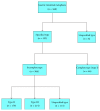The Prevalence of Gastric Intestinal Metaplasia and Distribution of Helicobacter pylori Infection, Atrophy, Dysplasia, and Cancer in Its Subtypes
- PMID: 26635875
- PMCID: PMC4655281
- DOI: 10.1155/2015/434039
The Prevalence of Gastric Intestinal Metaplasia and Distribution of Helicobacter pylori Infection, Atrophy, Dysplasia, and Cancer in Its Subtypes
Abstract
Objectives. Gastric intestinal metaplasia (IM) is frequently encountered and is considered a precursor of gastric adenocarcinoma. In the Van region of Turkey, gastric adenocarcinoma incidence is high but the prevalence of gastric IM is not known. Helicobacter pylori (H. pylori) infection is a main factor leading to atrophy, IM, and cancer development in the stomach. The aim of the current study was to investigate the prevalence of IM and its subtypes and the prevalence of H. pylori infection, atrophy, dysplasia, and cancer in gastric IM subtypes. Materials and Methods. This retrospective study was conducted on 560 IM among the 4050 consecutive patients who were undergoing esophagogastroduodenoscopy (EGD) with biopsy between June 2010 and October 2014. Clinical records and endoscopic and histopathologic reports of patients with IM were analyzed. Results. The prevalence of gastric IM was 13.8%. The prevalence of incomplete IM was statistically significantly higher than complete IM. Type III IM was the most frequent subtype. Conclusions. Gastric IM is a common finding in patients undergoing EGD with biopsy in this region. High prevalence of incomplete type IM, especially type III, can be associated with the high prevalence of gastric cancer in our region.
Figures
References
-
- International Agency for Research on Cancer. Schistosomes, Liver Flukes and Helicobacter Pylori. Lyon, France: IACR; 1994.
LinkOut - more resources
Full Text Sources
Other Literature Sources


